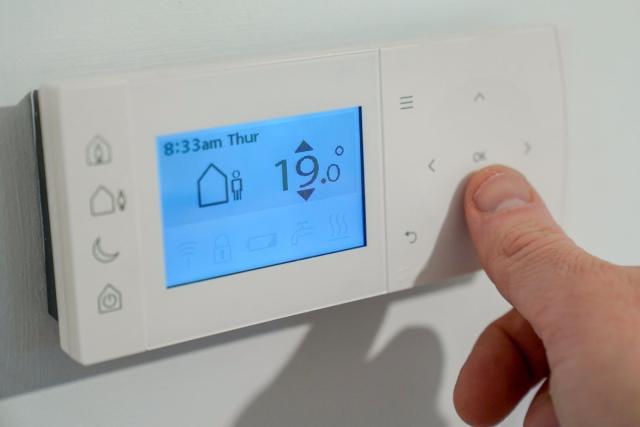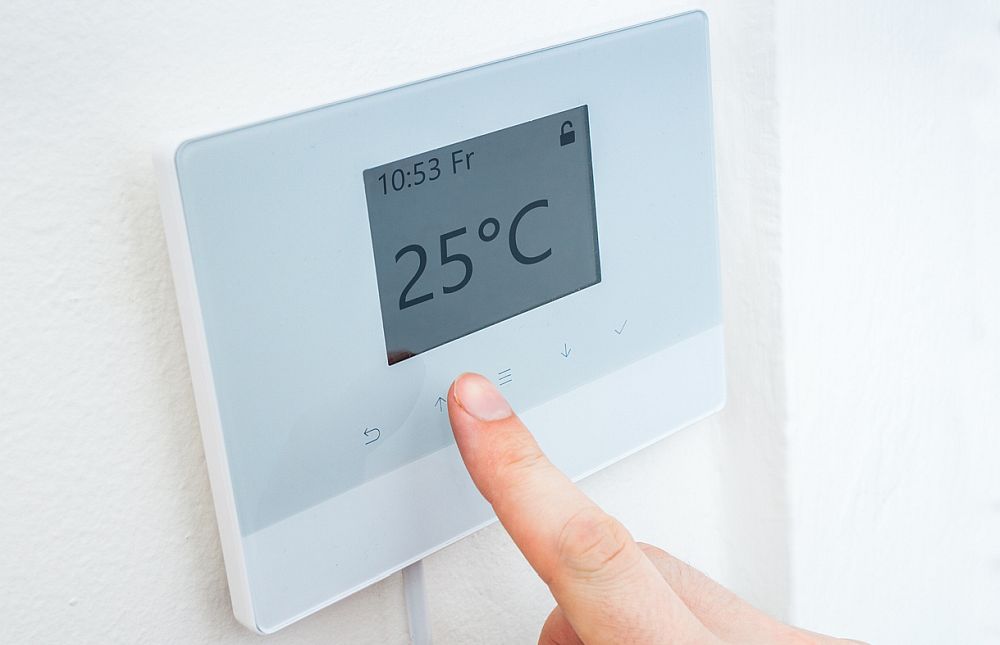The temperature inside a house can drop at a rate of approximately 1 to 2 degrees Fahrenheit per hour. When using a central air conditioning system.
However, this can vary depending on factors like the home’s size and insulation, outdoor temperature, and initial indoor temperature. Typically, a home can remain warm for about 8 to 12 hours after a power outage before the gradual cooling process begins.
The efficiency of your cooling system, the quality of insulation, and outdoor weather conditions. It can all affect how quickly your home cools down. These factors can impact the effectiveness of your cooling efforts. So, it’s important to consider them when trying to cool your home efficiently.
Factors Affecting Rate of Temperature Drop

Here are factors affecting the rate of temperature drop in a house.
Type of Cooling System
When considering how quickly a house can cool down, the type of air conditioning system being used plays a significant role. Central Air Conditioning systems are designed to cool an entire house by circulating cool air through a system of ducts.
Due to the requirement to keep the entire space at a constant temperature. These systems could take longer to cool a house.
On the other hand, Window Air Conditioners and Portable Air Conditioners are typically installed in a single room or specific area of the house. They can cool a room more quickly than a central system. But may not be as efficient at cooling the entire house.
Evaporative coolers, sometimes referred to as swamp coolers, work best in dry environments. They cool the air by letting it pass through moist pads. They might be able to quickly cool a room this way. They could fail to perform as well in humid environments, though.
Room Size and Insulation
The rate at which a room or residence cools down could possibly vary depending on its size. Because there is more air to distribute and cool, larger rooms or homes could take longer to cool.
Proper insulation can help retain cool air and prevent warm air from entering the house. Houses with good insulation will generally cool down more quickly than those with poor insulation.
Outdoor Temperature and Humidity Levels:
High outdoor temperatures and humidity levels can make it more difficult for a cooling system to maintain a comfortable indoor temperature. This is because the cooling system has to work harder to cool the air and remove moisture.
Further, cooler outdoor temperatures and lower humidity levels can make it easier for a cooling system to cool the air. This can maintain a comfortable indoor temperature.
Initial Indoor Temperature
If the indoor temperature is significantly higher than the desired temperature. The cooling system will need more time to bring it down. This is because the cooling system has to work harder to cool the air and bring it to the desired temperature.
Thermostat Settings
Setting the thermostat to a lower temperature than necessary can strain the cooling system and delay reaching the desired temperature. It’s best to set it to the desired temperature and avoid excessive cooling.
Conversely, raising the temperature when the house is empty can save energy and help the system reach the desired temperature faster when you return.
Proper Maintenance
Regular maintenance of cooling systems, including cleaning filters and coils, can ensure optimal performance and efficiency. This can help the cooling system cool the house more quickly and efficiently.
Ideal Rate of Temperature Drop

The ideal rate of temperature drop varies depending on several factors. These include the type of cooling system used and the size and insulation of the home. The first indoor temperature, as well as the outside temperature and humidity levels. Furthermore, the optimal rate of cooling depends on several thermostat settings.
Here are some general guidelines for the rate of temperature drop for different cooling systems:
Central Air Conditioning
Temperature decreases at a rate of 1-2 degrees Fahrenheit every hour. Central air conditioning systems are often designed to offer whole-home cooling. They may thus need more time to lower the temperature in many rooms.
Window Air Conditioner
There is a one to three degree Fahrenheit decline in temperature per hour. To chill certain rooms or locations, window air conditioners are frequently utilized.
Thus, compared to a central system, they might chill a space faster. To chill the entire house, though, may still take some time.
Portable Air Conditioner
One to three degrees Fahrenheit are lost from the temperature per hour. Portable air conditioners are mobile and may be used to cool off certain areas of the home.
Still, they could take longer, like window units, to chill the entire house than central systems.
Evaporative Cooler
Rate of temperature drops by 2-4 degrees Fahrenheit per hour. They work best in dry climates and can cool a room quickly. However, they might not be as effective in humid conditions.
Tips for Efficient Cooling

Here are some tips for efficient cooling
Regular Maintenance
It is key to ensuring your cooling system operates efficiently. First, regularly change your air filters as dirty ones restrict airflow, making your system work harder.
Next, clean the evaporator and condenser coils from dirt and debris to improve heat absorption and dissipation. Finally, check for leaks in ductwork and refrigerant lines, as leaks can significantly reduce efficiency and cooling capacity.
By following these steps, you can help your cooling system run smoothly and maintain a comfortable indoor temperature.
Proper Insulation and Sealing:
To maintain a consistent indoor temperature, proper insulation is essential. This includes insulating your attic, walls, and floors to reduce heat transfer between indoor and outdoor environments.
Additionally, sealing gaps and cracks around doors, windows, and other openings. It can prevent cool air from escaping and warm air from entering. Use weatherstripping and caulking to seal these areas effectively.
Ceiling Fans and Ventilation:
Ceiling fans can be a useful tool in managing indoor temperatures. They create a wind-chill effect that can make you feel cooler. As well as enabling you to raise the thermostat setting slightly without sacrificing comfort.
Furthermore, natural ventilation is beneficial. Opening windows and doors during cooler periods of the day or when outdoor air is less humid can allow for fresh air to circulate indoors.
Also, consider using exhaust fans in kitchens and bathrooms to remove heat and humidity, contributing to a more comfortable indoor environment.
Thermostat Settings
A programmable thermostat is a valuable tool for managing indoor temperatures and saving energy. By setting different temperature schedules for various times of the day or week, you can optimize your cooling system’s efficiency.
The U.S. Department of Energy recommends setting the thermostat to 78°F (26°C) when you’re home and raising it to 85°F (29°C) when you’re away. Each degree higher than 78°F can save approximately 1-3% on cooling costs.
By using a programmable thermostat and adjusting settings based on your schedule, you can enhance energy efficiency and reduce cooling expenses.
Avoid Unnecessary Heat Sources
To minimize indoor heat, consider changing your cooking habits and using a microwave, slow cooker, or outdoor grill instead of the oven or stove. These appliances produce less heat and can help maintain a cooler environment.
Further, adjust your hot water usage by taking showers instead of baths and using cold water for laundry. This avoids unnecessary water heating, reducing the heat generated in your home.
Moreover, control solar heat gain by closing curtains or blinds during the hottest parts of the day. This can block out sunlight and prevent your home from heating up excessively.
Use Energy-Efficient Appliances
To reduce heat generated by lighting, consider switching from incandescent bulbs to energy-efficient LED or CFL bulbs. These alternatives produce less heat and consume less energy, contributing to a cooler indoor environment.
In addition, opt for energy-efficient appliances that generate less heat. For example, air fryers instead of deep fryers or toaster ovens instead of conventional ovens.
By making these adjustments, you can minimize heat buildup in your home and improve energy efficiency. Then, creating a more comfortable and sustainable living space.
Use a Dehumidifier
High humidity can make the air feel warmer than it is. Using it can help remove excess moisture from the air, making your home feel cooler and more comfortable.
Shade Your Home
To naturally reduce heat inside your home, consider planting trees or shrubs near windows and walls to provide shade. This can help block direct sunlight and reduce the amount of heat that enters your home.
Additionally, install awnings or shades over windows or patio areas to further block sunlight and prevent solar heat gain.
FAQ’s
How long does it take for the temperature to drop in a house?
The average home will remain warm for 8-12 hours after a power outage. Following this, there’s a gradual cooling over the next couple of days.
How many degrees should a house drop per hour?
A well-sealed and insulated home can lose between 1% and 5% of its heat each hour, or roughly 0.6°C (1.08°F) per hour. When the outside temperature is 0°C (32°F) and the interior temperature is 20°C (68°F).
How much heat should a house lose?
Approximately 25% of heat from a boiler escapes through the roof, 35% through walls and gaps, and about 10% through the floor.
How quickly should a room cool down?
On average, a room takes about 30 minutes to heat up or cool down. But this can vary depending on the specific characteristics of the home.
How long should an AC take to drop 1 degree?
It typically takes an average-sized air conditioning unit around an hour to lower the room temperature by one degree Fahrenheit. This occurs under typical conditions.
Final Words
When the power goes out, the temperature inside your house will start to drop after about 8 to 12 hours. It can cool down by about 1 to 2 degrees Fahrenheit per hour.
But remember, this depends on how big your house is, how good the insulation is, and how warm it is outside. The actual cooling rate can be different for each home.
Hence, it’s important to keep your house as cool as possible, especially in a power outage, to stay comfortable.
